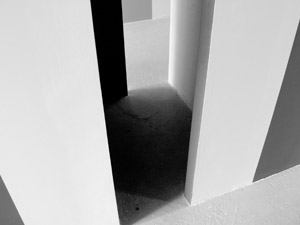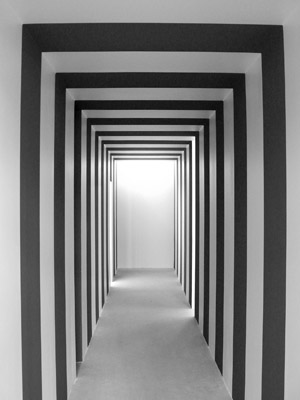Rodney LaTourelle
Program
2007:Mar //
The juxtaposition of monochromatic fields so that they interact has of course multiple precedents in the history of art. The abstracted – that is to say non-figurative – use of colour in art carries with it historically specific cultural meanings; like the category of aesthetic judgement itself in Kant, colour is an empty potentiality just waiting to be filled-in with meaning. If Madame Blavatsky presided over the spiritual yearning of abstractionists like Kandinsky in the early part of last century, and if Clement Greenburg’s colour-field painters aspired to an updated secular type of transcendence roughly fifty years after that, the question remains, who is LaTourelle’s guru and with what aspects of the current cultural climate does his project express or at least reverberate with?
Although the question of the guru is admittedly a red herring, LaTourelle’s work has relational elements, making Bourriard an obvious if overly general frame of reference. More to the point is a contemporary world that the French thinker theorized as being in need of occasions for direct human interaction. If relational artworks address the dearth of such opportunities in the st Century, LaTourelle’s work offers a reflection on the wider cultural conditions that create this need. In his installation, the artist took care to ensure that the entrance from one section to the next was of the same dimensions as the vertical bars of color on its either side. He also made sure that each opening was where the light as opposed to the dark stripe would be in the work’s pattern of alternating colors. This combined with the particular play of light, tone and shadow in the installation meant that each opening could appear to be solid, just another part of the wall, but one that you can step into. These thresholds provided the most effective illustration of the work’s intention. The distinction between the real and the fictive dissolves, and the viewer takes an active part in the flip between the two.
LaTourelle’s project zeros in on the pervasively immaterial quality of much of contemporary experience; to spend any significant amount of time on the Internet is to live your life with a foot each in two complimentary but very distinct worlds. And it is the taken-for-granted idea that the Internet – and digital communications generally – amount to another world, a Second Life as it were, that make it a pressing topic for critical reflection. Doing the show in Berlin at this time has an added resonance. LaTourelle’s work, monumental in scale, speaks to the recent appearance in the city of full-colour building scaled advertisements – a fictive world overlaid on but also apart of its less glamorous armature of support. For both economic and political reasons, the cityscape of Berlin up to this point has been refreshingly free of commercialism. The ads, all apparently given to the advertisers for free, are meant to confer the city with a patina of the economic viability it currently lacks. As such they meant to mark the transition between the city’s past and it’s supposed future, dissolving its specificity as a place into a mere way station in the circuits of globalism.
Rodney LaTourelle „In the Absence of Unambiguous Criteria“
Program
Invalidenstraße 115
11.01.‒24.02.2007

Rodney LaTourelle (© Courtesy Program)

Rodney LaTourelle (© Courtesy Program)